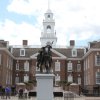Cape Henlopen High school bridges past to present with dedication of cornerstone
School officials past and present gathered Sunday, Nov. 7, a year after the new Cape Henlopen High School opened, to officially dedicate the school’s cornerstone.
With an eye to the future, many of the speakers focused on the history of the district, dating back to and before consolidation in 1969. “The excellence we have today has its roots many years ago,” said Walter Hopkins, a Lewes High School graduate. His father, William Hopkins, was a school board member from 1955 to 1972. “What my father worked the hardest on and had the most pride in was bringing consolidation to fruition,” he said.
|
What’s in the cornerstone?
|
|
Included in the more than 40 items in the 2010 Cape Henlopen High School cornerstone are a 1969 photograph of the first school board;
various class of 2010 event programs; the construction book from monthly meetings; photos of the school during construction; CDs of the 2010 yearbook and board policy; photo of the class of 2010; newspaper articles about the school; student items such as prom glasses, lanyards, Viking pins and graduation tassel; the 2010-11 student handbook. |
In 1969 the Lewes, Rehoboth and Milton school districts were combined to make the Cape Henlopen School District.
Local historian Hazel Brittingham, who worked for the Lewes and Cape Henlopen districts for 25 years, said the birth of the district evolved through desegregation and consolidation, although the two were not connected.
She said the first African-American students were enrolled in Lewes in 1959, but it wasn’t until 1966 that “colored schools” were closed when integration became federal law.
“Except for the quality of leadership in place, the outcome could have different,” she said.
On the heels of integration came rumors of consolidation. The Rehoboth and Lewes school boards had proposed consolidation of the two districts, but a push by Rehoboth voters vetoed the idea, Brittingham said.
State school districts didn’t have a choice when the General Assembly passed the Education Advancement Act in 1968; districts had one year to reorganize.
This time, combining the Lewes, Rehoboth and Milton school districts was part of the plan.
Brittingham said the amount of work required to get ready in a year was unbelievable.
The combined school boards had to be rehashed into one board – from 15 members to seven members. A new district office was opened at the location of the current Lewes Senior Center in Nassau, purposely out of any of the three towns.
The name Cape Henlopen was adopted and plans were discussed for a new high school. She said the new district was one of the largest in the state, encompassing about 10 percent of the state’s land mass.
High school students went to Lewes School on Savannah Road, but the placement of junior high students was not as easy. It was decided to use schools in Rehoboth and Milton as junior highs, which required long bus rides for some students. “Some parents were not happy campers,” she said.
Brittingham said the Lewes Pirates, Rehoboth Seahawks and Milton Warriors had to meld into the Cape Henlopen Vikings, a name selected by students. The district’s first high school opened in 1976, following a successful referendum in 1972.
She said Superintendent Frank Mercer was instrumental in creating the environment for a smooth transition.
Scott Walsmith, a 1957 graduate of Rehoboth High School who has had five children and three grandchildren graduate from Cape Henlopen High School, said the idea of consolidation was not popular in the Rehoboth Beach area.
The Rehoboth district was so small there wasn’t even busing, he said. In addition, there was an intense sports rivalry between Lewes and Rehoboth.
Walsmith, a Rehoboth district board member, eventually became a Cape Henlopen board member the first year of consolidation.
The first year was a watershed for the district. Christiaan Melson, president of the class of 1970, said students felt it would be hard to coexist with one another, but the exact opposite occurred. “When we walked through the doors on that first day we made friends,” he said.
Excellence in sports, the band and academics helped put the district on the map. “We had immediate success in academics and athletics,” he said. He called it a real miracle.
Jack Hudson, a 1965 graduate of Milton High School, said Milton residents considered themselves apart from those in Lewes and Rehoboth Beach. Milton was considered a farming area compared to the tourism industry in the resort towns. “We were more like Mayberry than the other towns,” he said.
Among those in attendance were former and current board members, administrators and staff, including three former teachers with more than 120 years of service:
Bertha Turner, who taught at Drawbridge Colored School and in the Cape district for 40 years; Hilda Norwood, who taught at Rabbit’s Ferry Colored School and in the Cape district for 44 years; and Anna Henry, who taught at Milton Colored School and in the Cape district for 42 years.
Superintendent David Robinson, a 1961 graduate of Lewes High School, said the event helped to serve as a bridge between the past, present and future. “It’s a new commitment to join hands for the Cape family,” he said.
Other speakers included Spencer Brittingham, board of education president; Sara Wilkinson, board of education vice president; Esthelda Parker-Selby, former board member; Brian Donahue, high school principal; Matt Kane, class of 2014 president; Matt Spencer, class of 2013 president; Jackie Coveleski, class of 2012 president; and Lydia Miller, class of 2011 president.


















































